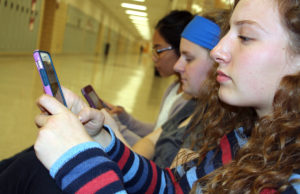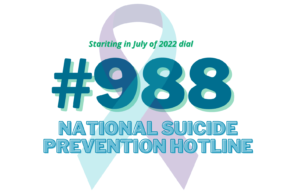Health Deficit: Mental health resources available for students dwindling in Iowa

As social media use has exploded in the last 10 years, pressures on teen mental health have also seen an increase, but resources available for assisting teens with mental health have seen a steady decline in Iowa.
Sophia Schillinger Photo
Celeste Ki felt isolated when she attended the Cedar Falls High School. She had few true friends, and the one she thought was by her side ignored her due to her mental health issue. Peers found fault with her because she had “no curves,” and because of that, said she wasn’t a “real woman.”
Adults were nice enough about her issues. They comforted her but didn’t address her mental problem as much as she needed. Ki found it challenging to receive the services she needed to meet her needs.
“For me, people just didn’t really talk about it. I felt the high school counselors were really nice about it, but that was about as much support that I could receive at CFHS. While I was there, adults didn’t really address it or talk about it,” Ki said.
Some of the faculty members that interacted with students like Ki even lacked basic mental health knowledge. “I received some counseling, which was good. I believe all teachers and faculty members that interact with students should have some basic knowledge of mental health issues and what they can do to accommodate their students,” Ki said.
Suzanne Freedman, a professor of human development at the University of Northern Iowa, teaches her students who are going to be future teachers about mental health issues, such as eating disorders and depression. However, she said she does not think that most teachers have this knowledge, especially if they have been teaching for awhile. She said that teachers today are being asked to do a lot more than just teach their subject matter.
Ki is still currently suffering from an borderline personality disorder, and she said she is recovered from anorexia nervosa. Her bulimic tendencies and restricting ways have lessened, but her BPD symptoms are just as prominent as they were in high school.
She has taken a different route to address her mental health issues as she is out of high school. She is now on medication and stopped seeing her psychiatrist during the summer of last year.
The toughest time for Ki was in ninth grade. “I was at my lowest weight. I was about 88 pounds and really lonely. All I could ever think about was calories, making sure I ate under 500 a day. Nobody really seemed to care about me, and instead actually insulted my body,” she said. “I didn’t have anyone that I could reach out to for a long time, and when I finally did, this friend didn’t respond to me at all and acted like it never happened after that. This was when I felt the most alone I had ever felt in my life.”
However, Ki felt like the counselors at the high school could comfort her, but were not knowledgeable enough to address her issues on the level she was looking for. “I received counseling at the high school, but they were the only people that really seemed accepting of me. Talking to them helped me because I really needed people who could listen to me, which is sometimes enough to feel validated,” Ki said.
The limited resources Ki was able to access are typical of Iowa high schools, and the trend is sliding more toward greater limitations each year.
At the Cedar Falls High School the three main areas counselors are knowledgeable about and will address the students about are academic counseling, personal/social and college and career options. “With less and less resources being available to be helped in schools, counselors have to try to take on the role of mental health counselors who treat BPD or anorexia.
“We’re school counselors. We’re not mental health counselors. Mental health counselors are going to be more in depth counseling, but I can still check in with kids. I can help them a little bit with moderating different behaviors and things like that. We’re just not trained enough to help with the BPD and the eating disorder,” counselor Susan Langan said. “School counselors sometimes end up doing things that aren’t related to school counseling. We can do personal/social counseling. We can do relationship issues, things that kids are going through with family and things like that, but anything long term, we refer out. We also do academic counseling and college and career things.”
For students who have mental health issues like anxiety, depression, etc., the high school has a mental health counselor come in twice a week who can talk to students about ideas that the school counselor is not trained to do. “We have been able to refer kids to her, and she has been able to help use when kids have been hospitalized. She is our connection there, but we need her full time,” Langan said. “It would be so much more helpful if we had her more than two times a week. We definitely have more kids we could refer to her if she was hear more.” With mental health needs increasing at other mental health centers in the community, the school district is at risk to lose their help. “I am nervous about this because Emily and the other mental health counselors go to elementaries, and they’re on a grant, and I am afraid with some of the cuts that are coming down the pike, they might not have the grant continued. They might also need more people in the Black Hawk Grundy Mental Health Center,” Langan said.
To add on to the problem of the lack of mental health resources, there is also an increase in students with mental health issues. “When I first started, maybe once a quarter, not even that, there would be a kid who is suicidal,” Langan said. “But it has changed, for a while it was once a week a kids that were hospitalized for depression or committing suicide or suicidal thoughts, between the four of us (school counselors).”
MENTAL HEALTH
RESOURCES
Mental health issues among students in Iowa are increasing, yet funding for mental health facilities in and out of school are decreasing. Resources are very limited in Iowa. According to the United Way of East Central Iowa, one in five children has a mental health disorder and less than half of those children are receiving mental health services in a given year.
Not just in Iowa, but schools across the country are left with little resources to help students, and are at a loss with what to do.
Nicole Skaar, school psychology professor at UNI and school psychologist at Belle Plaine High School, said, “I’m sure across the state there are small schools, rural schools, even large schools that are not sure what to do with kids who are in general education and have mental health issues, and there is nobody in the school to help them. It was happening in Belle Plaine before I started. I’ve heard from other principals across the state who are saying ‘I don’t know what to do with these kids.’ We really want to help them. We just don’t have the money or the capacity to do anything, so then they don’t get services.”
Most mental health services are provided by the Iowa AEA (Area Education Agency). Iowa’s AEAs provide special education support services, media/technology services, instructional services, professional development and leadership development. When mental health services are being cut from the budgets, which is happening more and more as years go by, the AEA is what is usually hit.
Skaar said, “One of the things we think about as school psychologists is that as budget cuts affect the AEA, which is how a lot of the services are provided to the schools. School psychologists and school social workers will have more and more students to serve, and when you have that caseload, you have to make sure you are doing your number one job, which is in special education: making sure the kids who need it get in special education and get matched up with the right services and those kind of things, and if we’re doing a lot of that, we’re doing less of our mental health role, so what has happened over time is that our caseloads have grown, and we are doing less and less mental health direct services for students. The focus is academics, so the first services to go generally are counseling, psychology services and social worker services and things like that.”
Resources are not just limited to those who are receiving services in schools. State hospitals are also suffering from the decrease in funding. In 2016, the Treatment Advocacy Center surveyed 50 U.S. states and the District of Columbia and found cutbacks affecting options everywhere. In the state of Iowa, there are a total of 64 hospital beds for mental health patients. This means two hospital beds per 100,000 residents. Iowa has the second smallest amount of hospital beds to Vermont’s 25 beds. For students who need emergency stays, this is an immense problem.
“We need more beds,” Skaar said. “In terms of emergency services, a student who has disciplinary kind of behavior issues at schools, such as being defiant and maybe even aggressive, they may have an emergency situation. This could be where they are being really, really aggressive to the point where that kid could hurt him or herself or someone else. Trying to find them a place in a residential treatment for even a short period of time, such as a 72-hour emergency stay or in a hospital for an emergency stay is really difficult.”
According to Skaar, not only is 64 beds for the state of Iowa, which has a population of around three million, not sufficient, but it is dangerous. Iowa population is growing, but the number of beds available to students and adults with mental health issues is decreasing.
The number of beds in 2010 was 149, which means that 85 beds have been lost in seven years.
Organizations around the country are trying to address the lack of funding for mental health issues, like the non-profit organization, Please Pass the Love. This organization is committed to increasing school-based mental health supports to improve the quality of life and educational opportunities for children, families and educators as well as offer culturally responsive comprehensive services and evidence-based supports to school systems.
“Since we are a non-profit, we seek to be sustainable without relying on money from the state,” said Jennifer Ulie-Wells, executive director of Please Pass the Love. “While we would love to have access to endless grants, we recognize that at any time grants and government-sponsored money can be eliminated. That said, the need for school mental health is only increasing. We work with thousands of young people, families, educators and community providers across Iowa and beyond. We are going to do everything that we can to be able to help schools implement effective school mental health interventions to improve the overall school climate and quality of life for everyone involved.”
But there is only so much the organization can do when funding is so tight. “There continues to be cuts in funding for education and mental health,” Ulie-Wells said. “This makes it very challenging to try to provide the necessary support to students when the financial resources are not available to do this effectively. It is also important to note that many children receive services through Medicaid. Unfortunately, Iowa does not have a very high Medicaid reimbursement rate, which makes it challenging for mental health professionals to make enough money to sustain business. It also makes it an undesirable field for medical professionals to choose when they can make significantly more money in other medical fields.”
SOCIAL MEDIA
Social media is another growing contributor to the pressure teens are facing.
“I think there is a lot of pressure, pressure they put on themselves, but society also attributes. I think everybody compares everyone to each others lives. They see all the positives flashed up on Facebook, Instagram, Twitter and Snapchat, etc. I think social media definitely plays a role in the anxiety and depression,” Skaar said.
Chelsea Dean, a graduate of Dunkerton High School who has dealt with multiple issues within her life, agrees with Skaar that social media takes its toll and that is a lot easier for people to hide behind a screen, post pictures and tweets about how they feel rather than opening up and talking about it.
Dean graduated in 2016 from Dunkerton High School while struggling with numerous obstacles throughout her four years.
She has dealt with depression and started self harming herself in her freshmen year. She was diagnosed with anorexia and bulimia and attempted to commit suicide on April 12 of last year.
Social media has become a routine in daily lives, and students have become accustomed to checking statuses, begging for likes and searching for themselves within a screen.
In 2015, almost 3 million teens, ages 12 to 17, had had at least one major depressive episode in the past year, according to the Department of Health and Human Services,
According to co-director of Alive&Running Suicide Prevention Troy Belmer, social media contributes to children’s and teenager’s low self esteem and low self assurance. “Social media is a big factor because it’s behind a screen. Lids can write whatever they want or feel without explanation,” Belmer said. “I think there is a deeper stigma than there ever has been, and I would tie a lot of that to social media. There is just a lot less interaction. Kids aren’t as good at opening up and talking to adults who can help.”
The other co-director and founder of Alive&Running Suicide Prevention, Ryan Nesbit, is certified in Mental Health First Aid training. He is also co-chair of the American Foundation for Suicide Prevention Iowa Chapter Board.
“The main reason schools invite me to speak or teach health class is my reputation.”
Nesbit presents a program at high schools and colleges called “Talk Saves Lives” that is a Power Point covering research, education, prevention and what each audience member can do to “know the signs.”
He said he feels mixing the educational Power Point with his real life story seems to have a great impact on the students and staff at each school that he has visited.
“My reputation for presenting a powerful view of suicide prevention is what has allowed me to speak at so many different schools and events,” Nesbit said.
Nesbit has gone to visit and present to schools and faculty all around the state of Iowa in a total of nine schools, seven churches and a few workplaces, but some schools are less welcoming than others.
“I have schools contact me. No schools have officially told me ‘no,’ but based on events and meetings that I have attended, I 100 percent believe that many schools are not open to having a guest speaker/teacher talk about suicide prevention. I will not specifically name these schools, but many of the schools in the Des Moines area would not be open to a presentation on suicide prevention,” Nesbit said.
Nesbit said he believes that social media dips into the issue of teen pressure that can lead to anxiety, depression and other mental health issues.
“Our overall society is suffering in the area concerning mental health. Life is fast paced for everyone, and we have lost the ability to just stop, relax and recharge,” Nesbit said. “We have become a selfish society that won’t take the time or make the effort to support each other. People no longer communicate face to face, and I believe that is unhealthy.”
After the climbing concern of social media, Nesbit said he believes the healthier version of communication is physical, face to face contact. Nesbit is totally against social media and that it only produces negatives.
Nesbit also said that communicating in person also expresses care and emotion that means more to someone when talking in person than over the works of social media sites.
“I fear that many people live in constant fear of being made fun of on social media. This is not healthy and can directly lead to anxiety and depression. I know the phones and social media are not going away. I also know that we need to control time spent on these devices and networks or bigger issues will soon follow.”
Belle Plaine High School Principal Todd Werner said he believes there is more than one source to the mental health issues such as anxiety or depression.
“I think technology contributes, but I don’t feel it is the only factor that is behind the difference in students now and maybe 10 years ago. Social media makes students and parents more exposed to issues that cause stress, and kids aren’t mature enough to manage these new issues,” Werner said.
Werner said that drawing attention to the issues, for instance, suicide, depression or anxiety, can lead to overexposure and results in making the problem of mental health issues bigger than it actually is. “This year alone I have heard more students in my school talk about suicide or self harming themselves than the previous seven years I have been a principal. I think a lot of that is due to more exposure through social media and places where kids interact with other kids from all over. They’re more aware of it and talking about it more, so I think they are having those feelings.”
DISTRICT
DISCREPANCIES
With Iowa being so miniscule, it doesn’t get noticed, so it doesn’t get the funding or support that bigger states might receive.
Skaar said, “There are some big names in mental health research that have put together school clinics and mental health clinics and have really done a good job at relieving the gap between community based mental health care and school based mental health care. Those places and those people are located in really large urban centers, such as Baltimore and Los Angeles. Iowa certainly doesn’t have that level of capacity and resources. Even Des Moines, which is our biggest city, still struggles with those things within the schools. I used to work at a small district on the north side of Des Moines, and even though we had lots of resources in the Des Moines area, many of our students went without services.”
One of those bigger states receiving more help and resources is Florida. Florida has 2,648 hospital beds compared to Iowa’s 64.
Urban and rural district mental health systems are addressed and funded differently. Rural areas tend to have less resources and less funding. Designated Health Professional Shortage Areas (HPSA) found that 60 percent of rural Americans live in mental health professional shortage areas.
According to two separate studies (a 2001 study in the National Center for Health Services and a 2005 study from the U.S. Department of Health and Human Services), there is evidence that rural communities have higher suicide rates and individuals experience greater stress due to high poverty rates, high unemployment rates and low educational opportunities. (National Center for Health Statistics, 2001; U.S. Department of Health and Human Services, Health Resources and Services Administration, 2005).
Professionals in school buildings acknowledge that there is a discrepancy between urban and rural districts regarding mental health services. “It’s hard, when you have small schools with very few resources, how do you do that?” Skaar asked. “One way I am trying to figure this out as a school psychologist and researcher is seeing if we can divert money from the local education agency to buy out time for a school psychologist or school social worker who has great knowledge of school and training in mental health systems and direct service to provide services to students at schools. Thus, if schools are getting money to hire behavioral coaches or interventionists or instructional coaches, etc., then maybe they could use that money to directly purchase time from a school psychologist or school social worker, because those people already have great knowledge of schools and school systems. I am actually working on a project for this upcoming school year that will actually do that.”
At some larger schools, they have extra help and are making the help available at nearby smaller schools. This is one way the discrepancies could be addressed.
Principal Todd Werner of Belle Plaine said, “Some of those larger schools should be based on need. Maybe someone working at one school who doesn’t have that many students in need should also be available to another school in the area whether it’s a larger school or a smaller school to kind of spread out the support. Some of the AEA agencies need to play a role in that, to make sure staffing is based on need — kind of like special ed services, trying to keep the number of teachers that work with special ed students balanced, but clearly it differs from district to district.”
Accessing mental health help in districts where resources are not close by can be very tricky for some students. This is especially true for students whose parents can’t financially afford it. “It’s hard,” Skaar said, “because we are a rural area, and we don’t have a lot of community-based mental health providers, and parents have to drive a really long way. It’s also really hard to do when parents are working, and when you have parents who are struggling to make ends meet in the first place, taking time off work isn’t always possible. Taking three hours out of the student’s school day and the parent’s work day once a week or twice a month or so is a lot of time lost. Having those services in the school can save the family a lot of time and money and a student a lot of instructional time.”
Celeste Ki and Chelsea Dean are still suffering from their mental health issues and the symptoms are still relatively the same. “I definitely do still suffer, all the symptoms are the same as they always have been, but I have learned to cope with them without medication now. However, this is not an easy option,” Ki said.
The two are able to make through dark days with love and support from her family, close friends and advice from professionals; the opportunities for Iowa teens to find the resources they need to directly address their mental health issues continues to become more and more limited.
By Sophia Schillinger and Teyha Tournier









You must be logged in to post a comment Login